

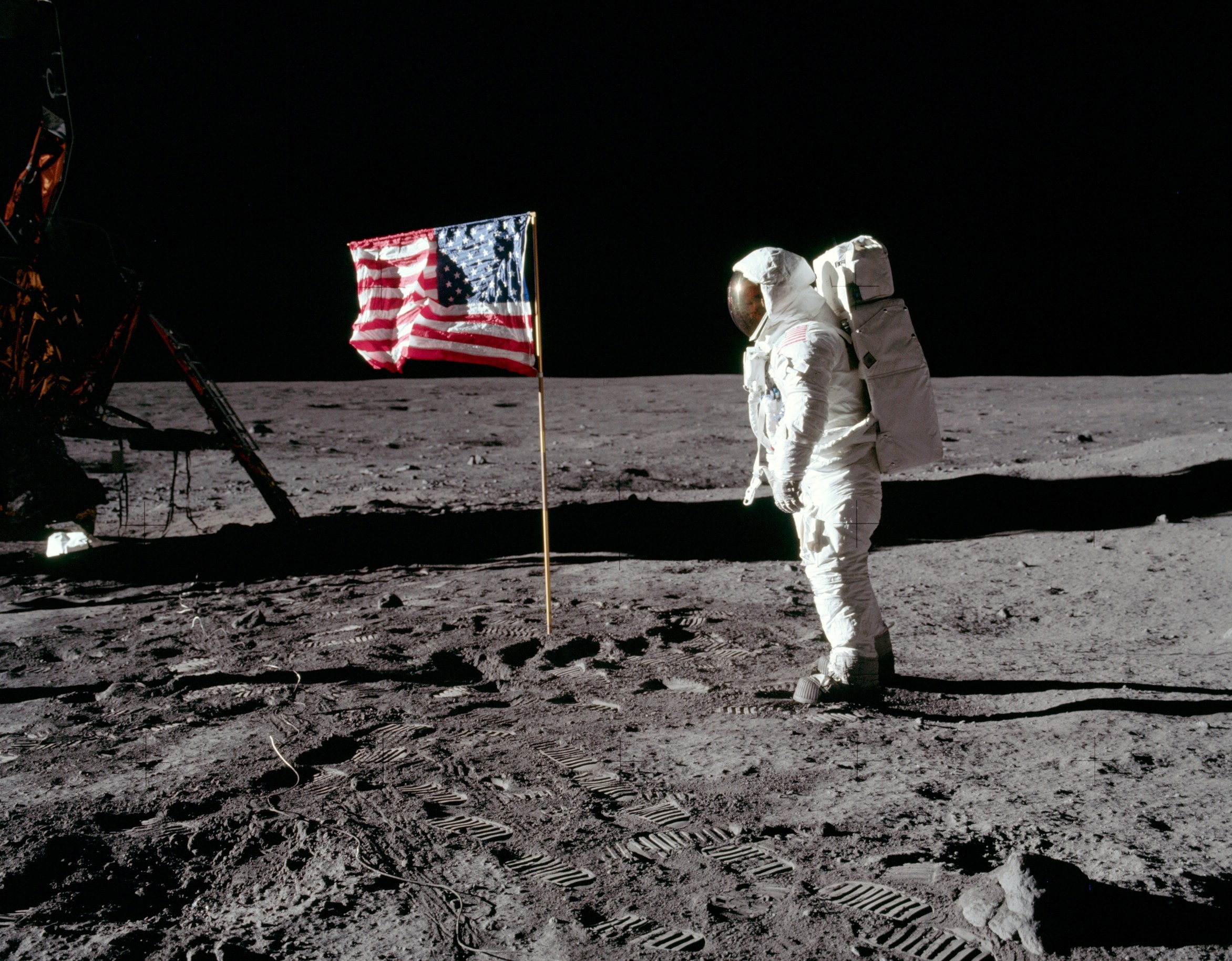
"We stand here in the dusk, the cold, the silence, and here, as at the first of time, we lift our heads."
(From his poem Voyage To The Moon) Archibald MacLeish
At 10:56 P.M. EDT, Sunday, July 20. Astronaut Neil A. Armstrong, spacecraft commander of Apollo 11. set foot on the moon. His descent from the lowest rung of the ladder which was attached to a leg of the lower stage of the Lunar Module {LM), to the footpad, and then to the surface of earth's only natural satellite constituted the climax of a national effort that began in 1961. It was an effort that involved, at its peak, more than 300,000 people in industry, the universities and in government.
As he took his epochal step, Armstrong commented "Thats one small step for a man, one giant leap for Mankind."
Sharing this electric moment with Armstrong and Edwin "Buzz" Aldrin, the LM pilot, were an estimated half-billion TV watchers in most of the earth's nations. As the astronaut descended the ladder, he pulled, a "D" ring that deployed a black and white television camera which was focused to record the event. Framed by parts of the LM's under-carriage, Armstrong's heavily-booted left foot descended across millions of TV tubes until his boot sole made contact.
Work on The Moon.
With the post landing checks completed, Armstrong climbed out of the LM and descended to the lunar surface. The moon walk began more than five hours ahead of schedule as a result of deciding not to have a rest period on schedule. Armstrong's attention was first directed at the nature of the surface material. He reported that the top layer was a fine, powdery material. He noted that he sunk in only a quarter of an inch or less, and that the footpads of the LM, which are convex discs 32 inches in diameter, had penetrated only a few inches. He also observed that the exhaust of the descent engine had not cratered the area directly below the LM engine nozzle.
After a quick visual check of the LM, Armstrong went ahead with his scheduled task of collecting the contingency sample - several pounds of lunar surface material which he stowed in a spacesuit pocket. In the course of his collecting, he noted that as he dug down five or six inches below the surface, he encountered hard, cohesive material. Armstrong had been assigned this collection as a first task to make sure that there would be samples aboard in case an early abort of the mission was necessary.
|
"Buzz" Aldrin descending the ladder of the LM. |
Astronaut footprint on the moon. |
Aldrin Leaves the LM.
Once the LM inspection and the sample collection were completed, Aldrin got out of the LM and climbed down the ladder, with Armstrong providing voice guidance. Armstrong was taking pictures of the event at the same time. The two then "unveiled" the plaque mounted on the strut behind the ladder by removing a protective covering. They read the inscription for the benefit of their world audience.
"Here Men From Planet Earth
First Set Foot Upon The Moon
July 1969 A.D.
We Came In Peace For All Mankind"
Report On The Lunar Surface.
Armstrong removed the TV camera that had covered his first step on the moon and transmitted several panoramic shots of the area surrounding the LM. The pictures came through with remarkably good definition and showed a fairly level area pitted with small craters. There was a scattering of boulders of varying sizes and shapes, some of them as large as two feet in their biggest visible dimension.
The astronauts described the surface color as varying from a very light to a dark grey. When in the spacecraft, Armstrong reported seeing some boulders that had apparently been fractured by the exhaust of the descent engine. Their surface was a light grey — perhaps coated with the powdery surface material. The fractures were very much darker. From the astronauts' comments, it appeared that the sun angle was a factor in color. When the variation between the sun angle and the viewing angle was zero, the surface looked almost white. The brilliance of the sun made the astronauts careful not to look in its direction. Conversely, the depth of the shadows made it difficult for Armstrong to watch his footing. It was evident that the wide swing in temperature between the 180 degrees F in the sun and the -160 degrees in shadow created no problems. At one point, Aldrin reported being cool and corrected the problem with an adjustment of the thermal control on his suit.
Armstrong set the TV camera on a tripod some 40 feet from the LM and adjusted its field of view so that it would encompass their subsequent operations. Mission Control suggested an adjustment to the left so that the camera's field of view centered on the LM in the background with a viewing angle wide enough to cover the area in which most of the activities would take place.
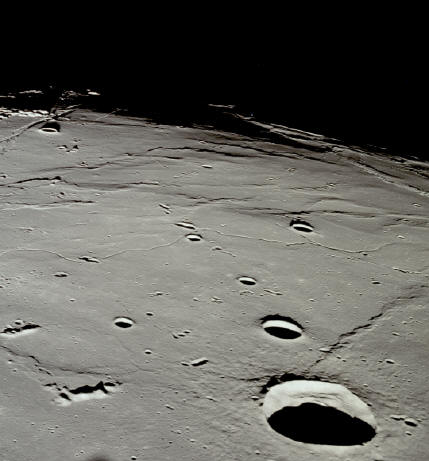
Approach to Landing Site #2 taken from lunar orbit. Crater Maskelyne at lower right. Shadow at lower left thrown by part of spacecraft.
Setting Up The Experiments
Aldrin then took the solar wind experiment and set it up. This was a narrow rectangle, about 4 feet long, of a foil-like material suspended from a rod that extended horizontally from the top of an aluminum staff. Aldrin forced the staff far enough into the moon's surface so that it would stand alone. He adjusted the rectangle so that it was aligned with the sun. After sufficient exposure, it would be taken down and brought back to earth.
The crew next deployed a specially structured 3' x 5' American flag. They fitted together its two-piece aluminum staff and deployed a support along its upper edge so that it would remain unfurled in the lunar vacuum.
A Phone Call From The White House.
With this task completed, Mission Control put through to the crew the longest long-distance telephone call in man's history. It originated in the White House and was relayed by the facilities at Mission Control to one of the giant dish antennas handling ground-moon communications, and thence to the LM crew. Advised that President Nixon wanted to talk to them, Armstrong responded, "That would be an honor."
President Nixon told the astronauts, "As you talk from the Sea of Tranquility, it inspires us to double our efforts to faring peace and tranquility to earth. For one priceless moment in the whole history of man, all the people on this earth are truly one."
When the conversation was finished, Armstrong and Aldrin faced the camera and saluted.
Collecting Samples.
The collecting of samples in bulk went forward without incident. Armstrong and Aldrin between them bagged upwards of 50 pounds {earth weight) of the loose surface material and selected rocks. These were stowed in small beta cloth bags and sealed and then packed in two large containers - also sealed - for eventual stowage aboard the LM. The crew used a scoop for the loose material and a pair of tongs to pick up the rocks. These tools were provided because it was thought that the space suits might make it impossible for the astronauts to bend far enough to retrieve objects from the surface. However, Armstrong subsequently dropped a film case and, after steadying himself against a strut of the LM, bent his knees and picked it up.
Both astronauts made a slow circle of the LM, examining it closely for damage resulting from the flight. They found nothing. The small thrusters called quads, the antennas, the struts and the skin of the lunar lander were in good condition.
The two main experiments were taken out of the LM and set up approximately 70 and 80 feet south of the LM. The distance was a safeguard against damage to the instruments by the ascent engine exhaust at take-off. The seismometer, designed to record and report events affecting the physical structure of the moon, began returning data immediately. It was sensitive enough to record the impact of the astronauts' feet on the moon's surface as they walked. The laser reflector which was to provide very precise information on the moon's distance from earth and its orbital path did not immediately function. The reason for this is not clear. A few days later it commenced operating.
Ease Of Movement.
In the long prelude to the flight, scientists had reservations about man's ability to move around in the lunar environment. The space suit, with its back pack of life support equipment, has an earth weight of 180 pounds. Moreover, in the lunar vacuum, the suit's internal pressure inflates it - a condition that substantially reduces its flexibility. There were also doubts as to human ability to adapt to the one-sixth gravity of the moon. It was feared that there might be a disorientation that might make movement awkward.
Armstrong and Aldrin quickly demonstrated that these fears were groundless, and enjoyed themselves thoroughly in doing so. Armstrong reported that the one-sixth G simulator in which they practiced at Houston. Both observed that the back pack tended to tip them backwards. Aldrin went through a series of movements, with a running commentary, to show TV watchers what could be done. He noted that it was important to know where the body's center of mass was and to keep a foot under it. He found it helped to lean in the direction of the movement and that turns were made easier by "cutting" in the manner of a running back in football. The "kangaroo lope", which some scientists thought might be the best method of lunar locomotion, worked - as the astronauts demonstrated -but not as well as the time-tested earthly method of simply putting one foot in front of the other.
The ease of movement on the moon's surface attested to by the fact that the astronauts ignored the rest periods that had been scheduled for them during the moon walk. Despite this, at no time during the exercise was there any heavy breathing. For the most part, the astronauts' heartbeat was lower than expected - lower, in some cases, than that of those at Mission Control who were watching. Armstrong's heart rate at one point reached 160 beats a minute, twice normal, but this was at the end of the walk when he was loading the rock samples into the LM. Pulse rates for both men were within the acceptable range throughout.
As he moved around, Aldrin commented that the rocks were rather slippery. "The powdery surface fills up the fine pores on the rocks," he said, "and we tend to slide over them rather easily."
During the moon walk, the TV transmission had a ghostly quality. The astronauts' white space suits, the grey tones of the moon's surface, the buoyancy of their movements, and the strange configuration of "Eagle" combined to give the impression that what viewers were seeing was truly from another world.
Besides the TV camera, the astronauts used a trio of other cameras for surface photography. They got both stilt and sequence coverage with a Hasselblad still camera, a Maurer data acquisition camera and the Apollo Lunar Surface Close-up camera.
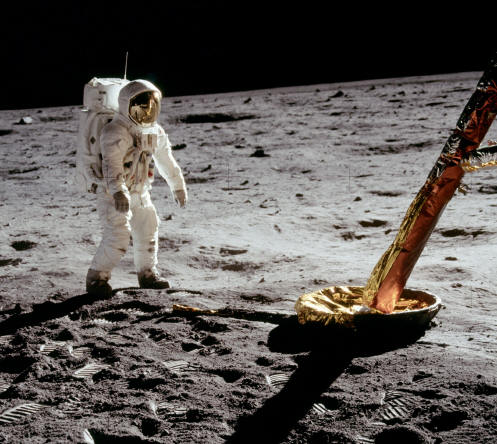
"Buzz" Aldrin walking in vicinity of Lunar Module. Footpad of Module is at right.
Re-entering The LM
After assurance from Mission Control that al! assigned tasks had been compieted, the astronauts prepared to re-enter the LM. Aldrin went in first and Armstrong transferred up to him the lunar samples and the film packs. At 1:09 A.M. EOT, Armstrong climbed the ladder and went through the hatch. Two minutes later, the hatch was secured. Armstrong had walked on the moon for 2 hours, 31 minutes and 37 seconds; Aldrin roughly 40 minutes less.
After removing the life support systems that had sustained them on the lunar surface, the two astronauts began a rest period lengthened beyond plan by the addition of the pre-walk rest that had been omitted after they first touched down. Armstrong rigged himself a hammock and Aldrin curled up on the LM floor. Neither slept well.
Shortly after 11 A.M. EOT, Ground Control roused the astronauts, and they began the last phase of their housekeeping in preparation for return to lunar orbit.
A tense countdown began and at 1:54 P.M. EOT, the LM ascent engine roared to life and propelled the LM upper stage upward on a vertical course at a rate that reached 54 mph at the thousand foot level. A burn of roughly 7 minutes of the ascent engine placed the LM in an elliptical orbit of approximately 9 nm by 45 nm. A short phase burn nearly circularized it at 49 x 45 nm, and four short additional burns of the reaction control thrusters brought the LM to the rendezvous with Collins in the Command and Service Module {CSM). Save for a brief and unwanted burn by a thruster, docking was accomplished without incident on the far side of the moon at 5:35 P.M. EOT. The LM was cast off and the Service Propulsion engine was fired at 12:56 A.M., July 22, to place the CSM on the long voyage home.
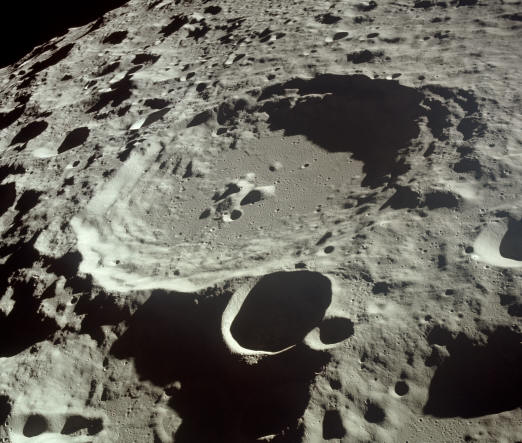
Oblique view of the lunar far side from lunar orbit. Large central crater is International Astronomical Union #308. It has a diameter of 50 statute miles.
LAUNCH TO LUNAR TOUCHDOWN
Four days earlier at 9:32 A.M. EOT, July 16, the five great engines of the Saturn V first stage ignited precisely on time, flaring a huge skirt of flame around the base of the rocket. After several static seconds for thrust buildup, the six-million-pound Saturn/Apollo lifted from the launch pad and moved purposefully up past the retracted gantry, gaining speed as it climbed. It was a perfect beginning for a nearly flawless flight
It was a The technical events of the pre-orbital phase -the roll sequence, jettison of the launch escape tower, first stage cut-off, second stage burn, second stage cut-off and third stage burn - took place with clockwork precision. With the shutdown of the third stage engine, both spacecraft and the stage entered a 103 nautical mile circular orbit exactly as planned.
On Course To The Moon
The crew
spent the next full orbit and part of the checkout. Over a point northeast of
Australia, Ground Co ntrol gave them "go" for insertion into their translunar
course. Re-firing the third stage engine increased velocity to roughly 24,200
mph - sufficient to break out of low-earth orbit into a free-return trajectory,
an elliptical course that if undisturbed, would loop the spacecraft around the
moon and bring it back to earth.
Once on course, the crew set about separating
the CSM from the third stage which still housed the LM in the protective shelter
of the panelled adapter section. The CSM was pitched 180 degrees, the adapter
panels were disposed of and the CSM was flown slowly back for docking with the
LM. The latter was separated from the third stage and the newly joined
components moved a safe distance from the stage. Ground Control ordered the
stage to dump its fuel - a move that propelled it into a course around the moon
and thence into solar orbit. The spacecraft continued its outward coast to the
moon.
Though it left its earth orbit speeding at more than 24,000 mph, relative to earth, the gravitational pull of the home planet steadily slowed the spacecraft until itsvelocity had been cut to slightly over 2,000 mph. At this low point, the Apollo was approximately 34,000 nrn gravitational field is stronger than that of earth and the spacecraft, accordingly, began to pick up speed.
The acceleration continued until, at the point of insertion into lunar orbit, the spacecraft was travelling roughly 4,000 mph relative to the moon.
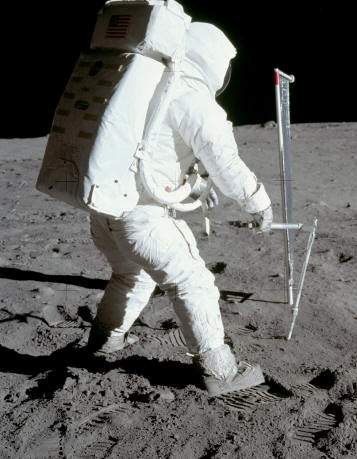
Astronaut Edwin Aldrin is in the process of taking a lunar soil sample. In the background is the solar wind experiment.
Into Lunar Orbit
When Ground Control had given "go" for insertion into lunar orbit, the crew braked the spacecraft with a retrograde burn of the Service Propulsion engine and slipped into an egg-shaped orbit of 61.3 nm at low point and a high point of 168.8 nm. A short retrograde burn at the low point altered the orbit's dimensions to the nearly circular course of 65.7 nm by 53.8 nm. After the LM had separated for its descent to the lunar surface, Collins in the Command Module (CM), would remain in this orbit, a lonely monitor of surface operations until Armstrong and Aldrin flew the LM up to rejoin the mother ship.
Following the orbital correction Armstrong and Aldrin crawled through the docking tunnel into the LM for housekeeping and a systems and equipment checkout in preparation for their descent to the moon's surface. At 1:46 P.M. EOT, the LM undocked from the CSM.
To The Surface Of The Moon
An hour and 22 minutes later, the descent maneuver began with a retrograde burn of the LM's descent engine that placed the LM in an elliptical orbit with a low point 8.5 nm above the moon. When the orbital low point was reached, the powered-descent stage started. This involved dropping the LM out of orbit into an arching glide with a terminus on the moon's surface. The glide path had two check points: one called "hi-gate" at an altitude of 7,600 feet and 26,000 feet laterally from "lo-gate," 500 feet in altitude and adjacent to the landing zone. During the glide the spacecraft's velocity would be cut from 342 miles an zero. The descent went as planned and as the LM reached "lo-gate," its attitude approached the vertical to the moon's surface. As the LM dropped below 500 feet in altitude, the crew transmitted a staccato numerical report to Ground Control on its rate of drop and lateral movement.
A few seconds from touchdown, there was a break in communications providing a few tense moments, the next thing heard from the crew was:
"Houston. Tranquility Base here. The Eagle has landed."
During the communications break, the crew saw that their line of approach would take them into a crater the size of a football field covered with large rocks. Armstrong took manual control and flew the LM to a site four miles away and then gently set the LIVI on the lunar surface. When he cut off the descent engine, he had 30 seconds worth of fuel remaining. During this maneuver, Armstrong's heartbeat went from a normal 75 to 150. Point of touchdown was estimated to be about 120 miles southwest of the crater Maskelyne, although for a considerable period no one was sure of Eagle's exact location.
Aldrin immediately began describing the view from his window. ". . . . it looks like a collection of just about every variety of shapes, angularities and granularities, every variety of rock you could find. ... it looks as though they're going to have some interesting colors to them."
HEADING FOR HOME
Compared to the earlier stages of the flight, the return leg of the mission was routine. So precise had been the Service Propulsion engine firing that only one of several planned midcourse corrections was needed, and that a velocity change of only 4.7 feet per second.The astronauts busied themselves with housekeeping chores and rested. Early on July 24th, the crew began make ready for re-entry and splashdown. Rough weather in the planned landing area forced a shift to an alternate aiming point 215 miles down range. The spacecraft re-entered the atmosphere at 400,000 feet at 12:35 P.M. EOT, and 13 minutes later splashed into the Pacific Ocean approximately 825 nm southwest of Hawaii. The landing was within 13 nm of the prime recovery ship Hornet.
A Scrubbing
A half-hour after splashdown, a frogman in an isolation suit passed three isolation suits through the spacecraft hatch. The only difference between the suits worn by the frogmen and those given the astronauts was in the helmet. The astronauts' exhalations and the frogmens' inhalations were filtered. With President Nixon looking on from the bridge of the Hornet, the astronauts climbed into a rubber boat and were scrubbed down with an iodine solution by a frogman. The astronauts, in turn, scrubbed down the frogman. After the crew had been lifted into the helicopter, the Apollo spacecraft got a similar scrubbing. The isolation garments and the scrubbing were phases of the elaborate precautions against possible, but unlikely, contamination by lunar organisms.
Aboard the carrier, the crew entered the mobile isolation unit where they remained until reaching Houston. At the Manned Spacecraft Center they were Laboratory where they were to complete their 21-day period of quarantine (calculated from the time of their departure from the moon).
The President's greeting to the astronauts was delivered below decks on the Hornet to the trio who were clustered behind a small window in the rear of the mobile unit. In congratulating them he stated, "As I travel into Asia and Europe, I'm going to find that as a result of what you've done, the world's never been closer together. We can reach for the stars just as you have." The President also extended an invitation to dinner.
Safeguards Against Contamination.
Precautions to ensure that the astronauts would not introduce to earth microorganisms peculiar to the moon began before the liftoff from the lunar surface. The crew left on the moon items that had sustained maximum exposure to lunar material such as their outer foot gear. Before rejoining Collins in the CSM, Armstrong and Aldrin gave themselves a thorough vacuuming with an attachment that hooked onto the air hose of their suits. The LM interior was also vacuumed, and the cabin atmosphere triple-filtered. As they crawled through the docking tunnel, Cotlins maintained higher atmospheric pressure in the CSM than in the LM which had the effect of erecting an air barrier against the LM atmosphere transferring to the CSM. Once in the CSM, with the tunnel sealed, the vacuuming operation was repeated.
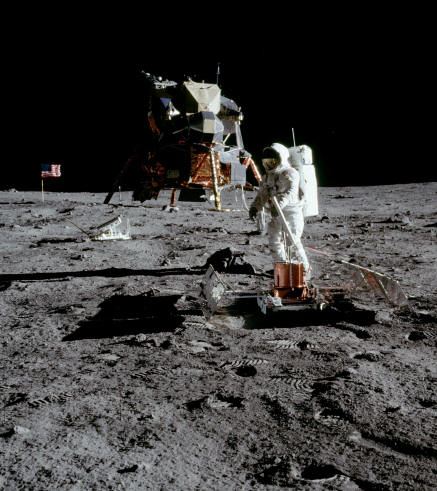
Aldrin prepares to deploy two experiments: the seismometer and the laser reflector.
Records and Firsts.
As might be expected from the nature of the mission, Apollo 11 established a number of records and "firsts." It put the largest payload ever in lunar orbit. In the 8-day mission, the TV networks beamed abroad, via satellite, telecasts totaling 230 hours. Comsat estimated viewers totaled 500 million. It was the healthiest flight. None of the crew had to resort to the medical kit for any reason. All phases of the lunar touchdown, the rnoon walk, and the ascent to 50,000 feet were "firsts." A record number of people watched the launch. Local Civil Defense officials estimated 1,000,000. Watchers pitched tents on nearby beaches and dunes, filled the motels and hotels and created a massive traffic tie-up. More than 3,000 newsmen from 55 countries besides the U.S. were on hand to report the event. Japanese news media were represented by a press corps of more than 100 correspondents.
TV from Space.
Highlighted by full in situ coverage of the moon walk in black and white, the astronauts' telecasts began with an unscheduled transmission on the second day of the flight, followed by a second scheduled effort lasting an a half-hour. At 4:40 P.M. EOT on the third day, the crew put on a color telecast that lasted more than an hour and a half. Picture resolution and quality were exceptional. Coverage included the interior of both the CM and the LM. The opening of the docking tunnel was photographed and the astronauts were depicted at work in the LM. Exterior views of the spacecraft were also shown, as were views of the earth.
The telecast of the moon walk had a double value. It brought to the general audience a portrayal of humans in the lunar environment and gave, as well, scientists and provided by the astronauts on their capabilities to move and work on the moon.
On the return leg, two programs were transmitted. An eighteen-minute sequence featured a demonstration of the physics of weightlessness. Collins filled a teaspoon with water and demonstrated "pouring"; i.e., he turned the spoon upside down and the water remained in place. A spinning can of cheese served to illustrate how a gyroscope works. There was a lesson on how to drink water in space. Some final shots of the earth and the moon were included. The second transmission featured messages of appreciation from each crew member to all the people who helped make Apotlo 11 possible.
Foreign Reaction.
Interest in Apollo 11 was intense and worldwide. The heads of state of 74 nations sent message of Godspeed and good luck. By a microdot process, these were reduced 200 times so that they all fitted on a silicon disc about the size of a silver dollar. Although each message is no larger than the head of a common pin, they remain readable under a microscope. The disc was left on the moon.
Besides three American flags, the crew carried with them the flags of the 50 states, of U. S. territories, of the United Nations and of each nation diplomatically recognized by the United States. Two American flags were brought back for presentation to the Senate and the House of Representatives.
The crew also had with them medals in memory of Astronauts Grissom, Chaffee and White who were to have been the crew of the first manned space flight in the Apollo program. They also left a memorial for the two Russian cosmonauts who were killed.
British insurance underwriters, Lloyds of London, rang the Lutine bell, only done on rare occasions, tocelebrate the success of the mission.
Czechoslovakia and a number of other foreign nations, including the tiny Maldive Islands, issued special postage stamps. Several hundred Poles crowded into the lobby of the U.S. Embassy in Warsaw to watch the telecast of the moon walk. Applause was frequent during the transmission, and congratulations flowed freely. Among those cabling congratulations to President Nixon were Pope Paul VI, UN Secretary General U Thant, and Soviet President Nikolai V. Podgorny. Moscow radio began its 8 P.M. newscast with the term "Flash" and then reported that word of the completion of the Apollo mission had just come in and that "The courageous astronauts. Armstrong, Aldrin and Collins are again on our planet."
On the personal side, a Peruvian mother named her baby, born during the flight, after Neil Armstrong.
Thus, in 195 hours, 18 minutes and 35 seconds. Apollo 11 and Astronauts Armstrong, Aldrin and Collins moved the world into a new era.
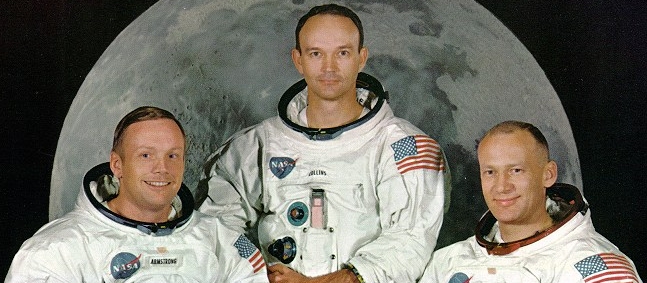
Astronauts Neil A.Armstrong (Commander for Apollo 11), Michael Collins (Command Module Pilot), Edwin E. "Buzz" Aldrin (Lunar Module Pilot).